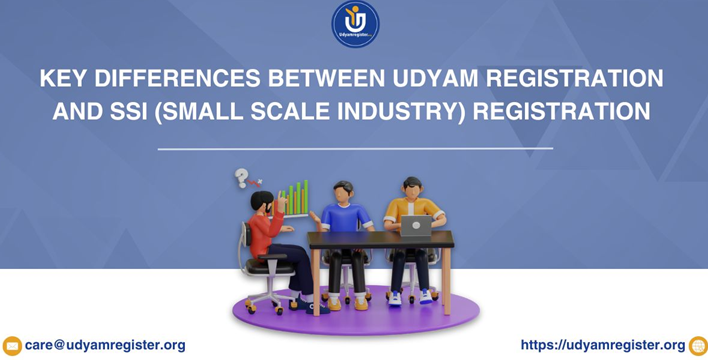Key Differences Between Udyam Registration and SSI (Small Scale Industry) Registration

Introduction
Udyam Registration and Small Scale Industry (SSI) Registration are two crucial initiatives by the Indian government aimed at supporting and promoting micro, small, and medium enterprises (MSMEs). Although both registrations serve the MSME sector, they have distinct features and purposes. Understanding the key differences between Udyam Registration and SSI Registration can help business owners choose the right path for their enterprise.
Purpose and Objectives
Udyam Registration:
- Introduced on July 1, 2020, Udyam Registration is aimed at simplifying the process for MSMEs to avail of benefits from various government schemes.
- It provides a unique identification number for MSMEs, enabling easier access to subsidies, schemes, and credit facilities.
- Focuses on formalizing the MSME sector by integrating it with the national digital ecosystem.
SSI Registration:
- An older system was used to register small-scale industries to provide support and recognition.
- Helped in availing benefits like tax rebates, incentives, and subsidies specific to small-scale industries.
- Primarily focused on promoting traditional small-scale industries.
Registration Process
Udyam Registration:
- Completely online and paperless process through the official Udyam Registration portal.
- Requires basic information such as Aadhaar number, PAN, and bank details.
- No physical documentation is required, and the registration certificate is issued online.
SSI Registration:
- Initially involved a manual process, requiring physical submission of documents to the District Industries Centre (DIC).
- Required extensive paperwork, including proof of business address, purchase bills, and details of machinery.
- The process could be time-consuming and complex.
Eligibility Criteria
Udyam Registration:
- Applicable to micro, small, and medium enterprises based on their investment in plant and machinery or equipment and turnover.
- Investment and turnover criteria are clearly defined to classify businesses into micro, small, or medium categories.
SSI Registration:
- Primarily focused on small-scale industries with investment limits defined for manufacturing and service enterprises.
- Had specific criteria for classification, which were often more rigid compared to the Udyam Registration norms.
Benefits and Incentives
Udyam Registration:
- Easier access to credit at lower interest rates.
- Eligibility for various subsidies, including technology upgradation and quality certification.
- Priority in government tenders and access to various support schemes from state and central governments.
SSI Registration:
- Provided benefits like tax rebates, power tariff subsidies, and financial support for technical upgradation.
- Facilitated access to raw materials and machinery at concessional rates.
- Enabled participation in exclusive development schemes for small-scale industries.
Integration with Digital Ecosystem
Udyam Registration:
- Integrated with government databases like GST and Income Tax for seamless verification and benefits disbursal.
- Offers a single-window system for registration and access to all MSME-related benefits.
SSI Registration:
- Lacked integration with modern digital systems and databases.
- Relied on physical verification and documentation, making the process less efficient.
Transition from SSI to Udyam
- With the introduction of Udyam Registration, the SSI registration process has been largely phased out.
- Existing SSI-registered businesses are encouraged to migrate to Udyam Registration to continue availing of government benefits and support.
- The transition aims to bring all MSMEs under a unified, streamlined, and digital framework for better governance and support.
Ease of Doing Business
Udyam Registration:
- Enhances the ease of doing business by simplifying the registration process and reducing bureaucratic hurdles.
- Provides a single certificate that is valid for the entire lifecycle of the business, eliminating the need for periodic renewals.
- The online system ensures quick processing and instant issuance of the registration certificate, promoting transparency and efficiency.
SSI Registration:
- The process could be cumbersome due to the need for multiple approvals and physical document submissions.
- Required periodic renewals and updates, which could be time-consuming and prone to delays.
- The manual nature of the process often led to inconsistencies and inefficiencies.
Financial and Market Access
Udyam Registration:
- Facilitates easier access to financial institutions and banks, making it simpler for MSMEs to obtain loans and credit.
- Offers collateral-free loans under various government schemes like the Credit Guarantee Fund Trust for Micro and Small Enterprises (CGTMSE).
- Provides opportunities for market access and export promotion through initiatives like the International Cooperation Scheme and participation in trade fairs.
SSI Registration:
- Provided some level of financial support but was not as comprehensive or streamlined as the Udyam system.
- Financial assistance was often subject to more stringent criteria and approval processes.
- Market access initiatives were limited and less integrated with digital platforms, making it harder for small-scale industries to compete globally.
Reporting and Compliance
Udyam Registration:
- Simplifies compliance by integrating with GST and Income Tax databases, reducing the need for redundant filings and paperwork.
- Provides a unified platform for all reporting requirements, making it easier for businesses to stay compliant with government regulations.
- The digital nature of the system ensures real-time updates and minimizes the risk of errors.
SSI Registration:
- Compliance and reporting were more complex and involved multiple agencies and departments.
- Required extensive documentation and periodic submissions, increasing the administrative burden on businesses.
- Lack of integration with digital systems often led to delays and discrepancies in compliance reporting.
Note: Print udyam certificate through udyam portal.
Conclusion
While both Udyam and SSI Registrations have played significant roles in supporting MSMEs, Udyam Registration represents a more modern, streamlined, and integrated approach. It aligns with the government’s vision of digital India and offers a host of benefits to enterprises, ensuring their growth and sustainability in a competitive market. Business owners should consider Udyam Registration to leverage these advantages and contribute to the nation’s economic development.





